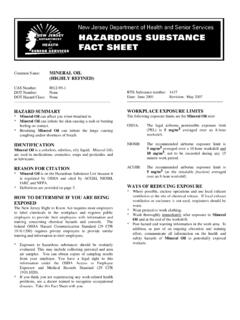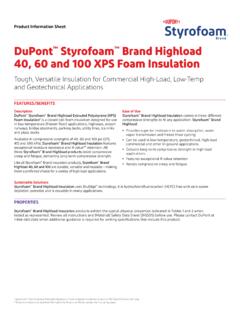Transcription of Compatibilizers: Creating New Opportunity for Mixed Plastics
1 Compatibilizers: Creating New Opportunity for Mixed PlasticsMay 2015 | Version : Creating New Opportunity for Mixed 2015 SPI: The Plastics Industry Trade Association 1425 K Street, NW, Suite 500 Washington, DC 20005-3686 This report is copyright 2015, SPI: The Plastics Industry Trade Association. All rights have long been used as a tool in the prime resin industry to create special resin blends that yield desired performance and properties that could only be obtained by a co-polymer blend of resins that would otherwise not be compatible. In layman s terms, compatibilizer additives allow resins that would not neatly blend together to talk to each other and bond in a way that creates enhanced performance when compared to either polymer alone.
2 Incompatible polymers prevent their practical use, such as in injection molding parts, because they delaminate during melt processing, causing rejects. Also, virgin polymers are chain scissored during melt processing and the resultant recycle resin has lesser mechanical properties when compared to the starting virgin resin due to the reduced molecular weight. The use of compatibilizers is being explored increasingly in the recycling industry as a way to create value in Mixed feed streams that cannot be further segregated by resin type, either due to technical challenges related to collecting, cleaning and sorting, or economic infeasibility.
3 THE OPPORTUNITYU nfortunately the situation that recyclers are seeing increasingly is a decrease in bale quality and yields. The residual materials that are left over after a bale has been processed are often sold for a few pennies per pound, if they can be sold at all, which is far less that the recyclers actually paid for the ma-terial as part of the bale. Recent findings suggest HDPE recyclers are suffering a 20-percent yield loss, while their PET recycling counterparts are experiencing upwards of 40-percent yield This rate of material loss can quickly change the economics of an operation from black to red.
4 Similarly, in bales of material where the resin types are inherently highly Mixed , such as bales of Plastics from electronics, the most desirable resin types like ABS and HIPS might only make up 60-percent of the bale. What is a recycler to do with the other 40-percent Mixed -fraction that might not be separable, again because of technical or economic infeasibility? If that yield loss could be put to use as another valuable feed stream, it can dramatically change the economics of an operation, as well as further divert valuable Plastics from the landfill.
5 In some cases, recyclers are finding that compatibilizers are key to recycling multi-resin products, such as flexible packaging. Without the use of compatibilizers, recovery of some packaging and products would not be possible. These layers of otherwise incompatible resins can be blended and then used in varying levels to make panels and parts for durable goods, Creating a true upcycling story. A list of compatibilizers and the materials suppliers that offer them can be found in Appendix DIFFERENT COMPATIBILIZERS WORK1. Bipolar copolymer compatibilizers: A polymer can be incompatible with another polymer for a number of chemical reasons, including the fact that their polarities are different.
6 Polymers with dissimilar polarities can be made compatible by using bipolar copolymer compatibilizers that bridge the polar-ities. For example, Santoprene TPV (see data table) is a block copolymer of polar aromatic styrene monomer and non-polar aliphatic butadiene monomer. When the butadiene styrene block copolymer is added, its built-in bipolarity acts to attract the dissimilar polar polymers Creating a compatibility effect. This approach works well with known segregated streams such as a non-polar polyolefin with a polar polymer such as Nylon (PA) but is of limited value in post-consumer recycle streams containing a multiplicity of polymers that vary from batch to batch and within a given batch of recycle.
7 2. Maleated copolymer compatibilizers: Bond formation between maleic anhydride-g-polypropylene 1 Verespej, Mike. Kicking out Contamination, Resource Recycling, August : The Plastics Industry Trade Association3 SPI: The Plastics Industry Trade Association2 SPI: The Plastics Industry Trade Association(PPg) and polyamide 6 (PA) by in situ block copolymer formation can be called Fusion Bonding. Maleated polymers can be prepared directly by polymerization or by modification during com-pounding via the reactive extrusion process. Their anhydride groups can react with amine, epoxy and alcohol groups.
8 For example, Fusabond M603 Resin (see data sheet ) is a random ethylene copolymer, incorporating a monomer which is classified as being a maleic anhydride equivalent for application uses. The exact composition is considered to be proprietary , styrene maleic anhydride, also known as SMA or SMAnh, is a synthetic polymer that is built-up of styrene and is another suitable agent for compatibilizing normally incompatible polymers such as PA/ABS blends. The limitation of this class of additives is their specificity requiring known chemistry and of the polymers to be compatibilized.
9 In addition, maleic anhydride depolymerizes condensation polymers such as PET and PC, thus obviating their use in Mixed streams such as PCR containing olefins, PET and assorted other In Situ Macromolecule Catalysts: Since monomers become polymers (macromolecules) in the pres-ence of catalysts and all polymers are catalyzed in situ macromolecular copolymerization of two or more dissimilar polymers in the melt via in situ catalysis using thermally stable organome-tallics holds the possibility of allowing the use of high levels of PCR in consumer brief study of the history of polymer catalysis using Ziegler-Natta and Metallocene catalysts de-fines a path for future development.
10 Zielger-Natta catalyst: Metallocene as Olefin Polymerization catalysts: forms of organometallics known as titanates, zirconates, aluminates and zirco-aluminates provide possible chemistries for R&D programs in making high levels of PCR in consumer goods a reality since they are used as esterification catalysts for PET and single-site metallocenes catalysts for polyolefins. In addition, it is possible that this class of catalysts is synergistic with maleated copolymers. The disad-vantage of this class of additive is its use is not as yet well known to the recycling industry and recyclers in general are not R&D chemists and require the offering of simple additive systems and processes that can be replicated easily in a practical manner at a reasonable cost.





